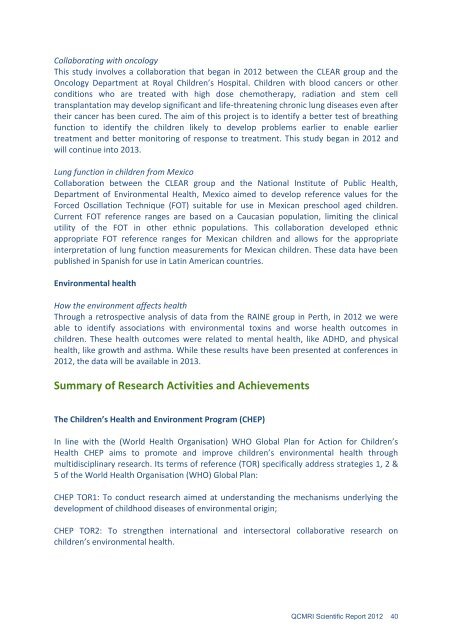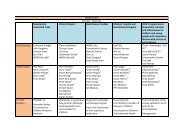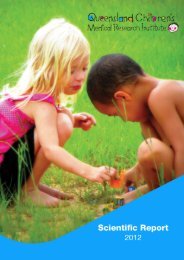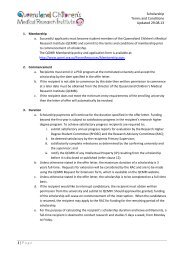2012 Scientific Report - Queensland Children's Medical Research ...
2012 Scientific Report - Queensland Children's Medical Research ...
2012 Scientific Report - Queensland Children's Medical Research ...
You also want an ePaper? Increase the reach of your titles
YUMPU automatically turns print PDFs into web optimized ePapers that Google loves.
Collaborating with oncology<br />
This study involves a collaboration that began in <strong>2012</strong> between the CLEAR group and the<br />
Oncology Department at Royal Children’s Hospital. Children with blood cancers or other<br />
conditions who are treated with high dose chemotherapy, radiation and stem cell<br />
transplantation may develop significant and life-threatening chronic lung diseases even after<br />
their cancer has been cured. The aim of this project is to identify a better test of breathing<br />
function to identify the children likely to develop problems earlier to enable earlier<br />
treatment and better monitoring of response to treatment. This study began in <strong>2012</strong> and<br />
will continue into 2013.<br />
Lung function in children from Mexico<br />
Collaboration between the CLEAR group and the National Institute of Public Health,<br />
Department of Environmental Health, Mexico aimed to develop reference values for the<br />
Forced Oscillation Technique (FOT) suitable for use in Mexican preschool aged children.<br />
Current FOT reference ranges are based on a Caucasian population, limiting the clinical<br />
utility of the FOT in other ethnic populations. This collaboration developed ethnic<br />
appropriate FOT reference ranges for Mexican children and allows for the appropriate<br />
interpretation of lung function measurements for Mexican children. These data have been<br />
published in Spanish for use in Latin American countries.<br />
Environmental health<br />
How the environment affects health<br />
Through a retrospective analysis of data from the RAINE group in Perth, in <strong>2012</strong> we were<br />
able to identify associations with environmental toxins and worse health outcomes in<br />
children. These health outcomes were related to mental health, like ADHD, and physical<br />
health, like growth and asthma. While these results have been presented at conferences in<br />
<strong>2012</strong>, the data will be available in 2013.<br />
Summary of <strong>Research</strong> Activities and Achievements<br />
The Children’s Health and Environment Program (CHEP)<br />
In line with the (World Health Organisation) WHO Global Plan for Action for Children’s<br />
Health CHEP aims to promote and improve children’s environmental health through<br />
multidisciplinary research. Its terms of reference (TOR) specifically address strategies 1, 2 &<br />
5 of the World Health Organisation (WHO) Global Plan:<br />
CHEP TOR1: To conduct research aimed at understanding the mechanisms underlying the<br />
development of childhood diseases of environmental origin;<br />
CHEP TOR2: To strengthen international and intersectoral collaborative research on<br />
children’s environmental health.<br />
QCMRI <strong>Scientific</strong> <strong>Report</strong> <strong>2012</strong> 40






